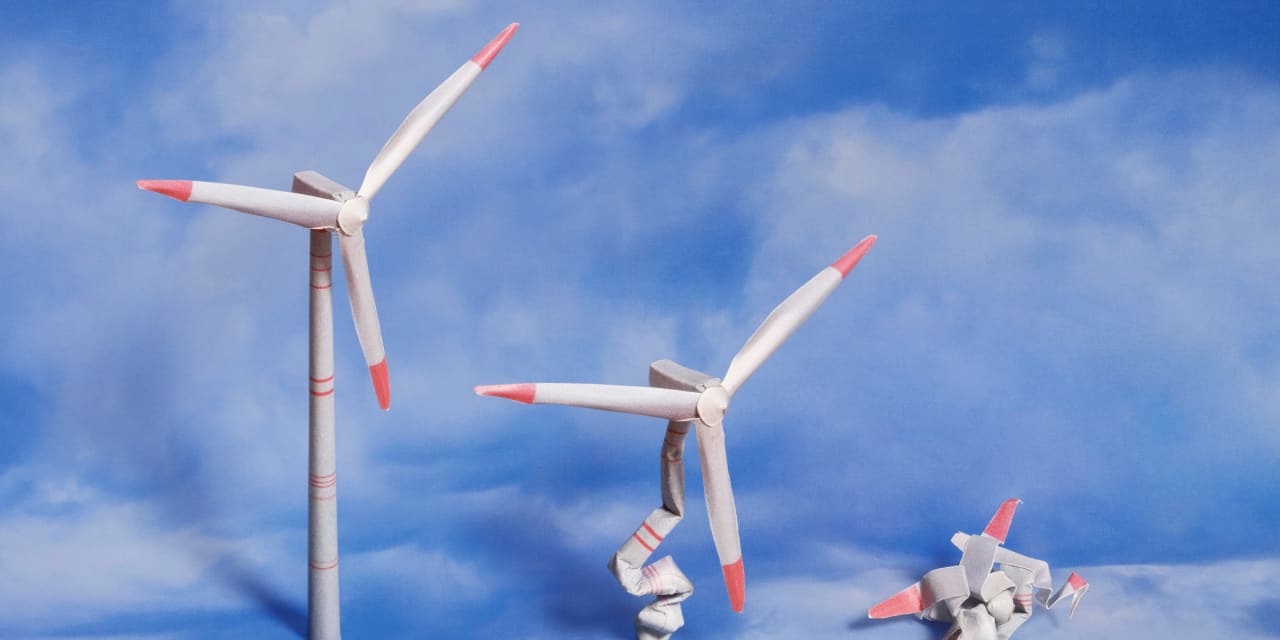Clean-energy stocks are suffering through their worst slump in years, causing the industry’s value to tumble by tens of billions of dollars and endangering America’s environmental goals.
Major auto manufacturers like
General Motors
(ticker: GM) and
Ford Motor
(F) have delayed plans to roll out electric vehicles. Offshore wind developers are canceling or delaying projects that were expected to provide millions of Americans with carbon-free electricity. Homeowners, even in climate-conscious states like California, are buying fewer solar panels for their roofs. And green-power producers known for offering steady, reliable dividends have lost their veneer of safety. Rising interest rates have posed the gravest challenge to the industry, but supply-chain problems, inadequate electric transmission infrastructure, and competition from China are hurting, too.
The fallout has caused 76 of the 77 stocks in the
Invesco WilderHill Clean Energy
exchange-traded fund (PBW)—a green-power benchmark—to fall for the past three months (the one stock to rise is a tiny fuse maker). The ETF itself is down 32% since the start of the year, compared with a 14% gain for the
S&P 500
index.
Most of those stocks look set to keep dropping. Solar and wind companies are awash in mispriced inventory and face an extended stretch of high interest rates; they’re probably several quarters away from a financial rebound. Newer tech like clean hydrogen is years away from profitability. While some clean-energy stocks do seem headed for a rebound, even those call for some caution.
Beyond the financial fallout, the setbacks in green energy have broad implications for the environment, particularly after the hottest summer on record. A consortium of scientists known as the Climate Action Tracker says the country is off track to meet its 2030 goal to roughly cut emissions in half from 2005 levels, and won’t get there “without additional, drastic emission reductions measures.” That will require all of the force that the clean-energy industry can muster.
There are political implications, too. America’s energy transition, a key pillar of President Joe Biden’s agenda, is under threat. Biden wants America to produce all of its electricity without emitting carbon by 2035, a goal that depends on lightning-fast installation of new energy infrastructure. Last year’s Inflation Reduction Act earmarked at least $369 billion for clean energy. To make the government’s investment pay off, companies will need to spend trillions more. Biden can ill-afford delays.
Serious as they are, the industry’s setbacks are not about to halt the energy transition. They look more like a detour than a derailment. Unlike in past eras, the shift to renewable energy now has powerful momentum. Just about every electricity producer and seller in America is on its way to going green, albeit at different speeds, and they often face penalties if they backtrack. Tech advancements have made renewables cost-competitive with fossil fuel plants in many states, even without government help. And industrial-size batteries are solving a longstanding problem for renewables: They are keeping the lights on even when the sun isn’t shining and the wind isn’t blowing.
There’s another big force supporting the transition: private money. Even as the stocks crater, private investments are cascading into the industry. Outside of electric vehicles, in fact, the majority of investment in clean energy is happening in private markets. From August 2022 to August 2023, private-equity firms had invested $108 billion in new renewable energy and energy storage projects in the U.S.—more than all of the publicly traded North American utilities and independent power producers combined, according to S&P Global Commodity Insights.
The transition is “the first major industrial and technology investment cycle that occurs primarily in opaque private markets,” says Peter Gardett, the executive director of climate and clean-tech research at S&P Global Commodity Insights.
Private-equity investors commit to long holding periods, and are less likely to react to day-to-day price gyrations. Copenhagen Infrastructure Partners, one of the world’s largest private clean-energy fund managers, is on track to raise 12 billion euros ($12.9 billion) for its newest fund by next year, despite the fact that a third of the fund will be invested in the most-troubled area in renewables—offshore wind. “That money is committed with us for many, many years, not just quarter to quarter,” says Tim Evans, a partner at the fund manager.
For investors who don’t have the institutional backing or personal wealth to buy into private funds, there are slim pickings in publicly traded stocks—but they do exist. The ones closest to rebounding look to be large producers of clean power. Thanks to long-term contracts that have remained intact, utility-scale producers like
AES
(AES) and
NextEra
(NEE) could eventually lead the sector out of its morass.
To understand what could go right in clean-energy stocks, it’s important to see what has gone wrong. The list is not short. It starts with high interest rates. Solar and wind projects, and new electric-vehicle plants, demand heavy upfront investments that should pay off over decades. With the cost of corporate debt doubling in the past two years, from 3.2% to 6.4% for Baa-rated bonds, it’s a bad time to be taking out new loans to finance capital projects. “It was an industry whose economics rested on low rates,” says Bobby Tudor, CEO of Houston-based Artemis Energy Partners, which invests in traditional and clean-energy companies. “When you have your cost of debt effectively doubling, it sort of wipes out your equity return.”
For companies that sell rooftop solar systems, high rates have complicated the sales pitch. Homeowners are less inclined to finance big home projects when interest costs rise. The Inflation Reduction Act gave homeowners a tax credit worth 30% of the value of their solar system, but even that credit can’t overcome customer doubts when rates are high. In states like Texas and Arizona, where retail electricity rates are low, solar has become a much harder sell, say installers and equipment-makers.
And in California—the No. 1 state for solar—new rules that reduce the rates that utilities pay to solar customers that generate excess power have curbed demand for panels. Residential solar developers like
Sunrun
(RUN),
Sunnova Energy International
(NOVA), and
SunPower
(SPWR) have been hit hard by these dynamics. Sunrun reduced its growth outlook this month due to the “difficult conditions in the sector.”
Residential solar companies face another headache in Europe, where the war in Ukraine has made fossil fuels more expensive and caused a surge in rooftop solar adoption. That uptick in demand is slowing now, just as China has flooded the European market with cheap solar panels that destabilized the market. The industry’s middlemen, known as distributors, are awash in inventory just as demand has slackened.
The result is a paralyzed supply chain that has sunk the stocks of solar-equipment makers like
Enphase Energy
(ENPH) and
SolarEdge Technologies
(SEDG), which had been some of the best clean-energy performers for years. Enphase has projected that fourth-quarter sales would fall 40% below analysts’ expectations, and warned that the malaise will stretch into 2024. “In the short term, it is going to be a stressful time,” Enphase CEO Badri Kothandaraman tells Barron’s.
The utility-scale solar market—the panels that are spread across fields that transmit electricity to power plants—is in somewhat better shape. Utilities are rate-sensitive, but they can pass rising costs on to consumers. And power producers are installing solar modules at a rapid rate today, with the U.S. on track to roughly double its utility-scale solar installations this year from last year’s level, according to energy consultancy Wood Mackenzie.
Solar manufacturer
First Solar
(FSLR) is the most prominent company in the utility-scale industry, and it has been the biggest beneficiary of Biden’s clean-energy bill. The company has secured orders for the next several years. But it’s still vulnerable to Chinese competition, depending on tariff decisions starting next year. The stock fell 25% in the past three months and may waver until tariff policy becomes more clear.
Onshore wind power, the largest source of renewable electricity in the U.S., is in even worse straits. Turbines dot the landscape throughout the Midwest and in states like Texas. But uneven tax subsidies, slow transmissions approvals, inflation, and other problems have kept installations below their 2020 peak for the past two years. It isn’t clear when the industry will get back on track, even with the more-reliable subsidies in the clean-energy law.
Offshore wind is in perhaps the worst position of all. That industry is just getting started in the U.S., with turbines now going up near Martha’s Vineyard, Mass., set to provide the country’s first commercial-scale power. The Biden administration has much higher hopes. Biden has touted offshore wind as a key technology to decarbonize the electrical grids in several high-population coastal states like New York and Massachusetts, announcing a goal of installing 30 gigawatts of offshore wind power by 2030—enough to power 10 million homes. But several projects have already been delayed or canceled due to increasing costs, including a recent decision by offshore wind market leader
Orsted
(DNNGY) to walk away from two projects in New Jersey that were expected to provide enough power for about a million homes.
S&P Global Commodity Insights just slashed its 2030 offshore wind projection to 12 gigawatts from 22 gigawatts last year. A senior Biden administration official said in a phone call that the industry is dealing with a “macro environment that presents headwinds,” but said that Biden still expects to hit the 30 gigawatt goal by 2030.
Among the few stocks that seem able to withstand these forces are large utilities that have been betting on renewables for years and have the capital to buttress results during difficult moments. NextEra, whose business is split into a regulated Florida utility and a more freewheeling renewable-energy arm, is a case in point. The utility, which still generates most of its electricity with fossil fuels, has seen steady returns. Investors have been less sure about the clean-energy arm, which is the largest renewable developer in the U.S.
An affiliated company that buys some of NextEra’s renewable projects warned investors in September that high interest rates were hurting its growth prospects, sending NextEra stock down. But NextEra management said on its latest earnings call that it has plenty of capital to fund its growth plans, including by selling tax credits through a new program authorized by the Inflation Reduction Act. Illustrating its resiliency, NextEra reported record bookings in its latest quarter and kept its earnings guidance through 2026.
NextEra’s business selling power through long-term contracts insulates it from most near-term pressures. Analysts have lifted their projections for NextEra’s 2024 earnings, even as they’ve been cutting them for other green names. NextEra nonetheless trades in line with the market today on a price/earnings basis, after historically trading at a 50% premium. The current stock price “offers a significantly attractive entry point,” writes Morgan Stanley analyst Dave Arcaro. He thinks that shares could rise to $79 from a recent $59.
Then there is AES, a Virginia utility that also builds large renewable-power projects across the country. Its stock has fallen 42% this year, but its growth trajectory remains intact. Analysts have reduced their 2024 earnings estimates by only 2% this year, and the company just reaffirmed its 7% to 9% earnings growth guidance through 2025. AES has made inroads in states with aggressive climate policies like New York, where it is the largest owner-operator of renewable assets and just won 1.2 gigawatts worth of new contracts last month. Arcaro thinks the stock could rise to $26 from a recent $16.
It will not take a magic trick for clean-energy stocks to rise again. Some combination of falling interest rates and better supply chains could go a long way. If those factors come together in 2024, clean energy once again could be riding high.
Write to Avi Salzman at [email protected]
Read the full article here









Leave a Reply